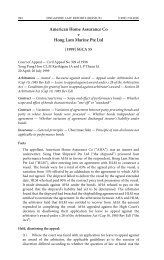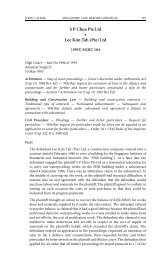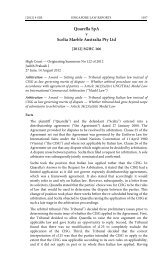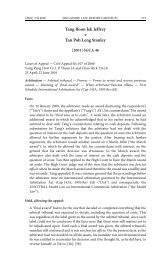[1996] 2 SLR(R) 292 - Lim Eng Hock Peter v ... - Singapore Law
[1996] 2 SLR(R) 292 - Lim Eng Hock Peter v ... - Singapore Law
[1996] 2 SLR(R) 292 - Lim Eng Hock Peter v ... - Singapore Law
- No tags were found...
You also want an ePaper? Increase the reach of your titles
YUMPU automatically turns print PDFs into web optimized ePapers that Google loves.
<strong>292</strong> SINGAPORE LAW REPORTS (REISSUE) [<strong>1996</strong>] 2 <strong>SLR</strong>(R)<strong>Lim</strong> <strong>Eng</strong> <strong>Hock</strong> <strong>Peter</strong>vBatshita International (Pte) Ltd[<strong>1996</strong>] SGHC 117High Court — Originating Summons No 237 of <strong>1996</strong>Amarjeet Singh JC3, 17, 25 April; 6 June <strong>1996</strong>Arbitration — Agreement — Tenancy agreement — Arbitration clause in agreement— Summons in chambers supported by affidavit to stay proceedings pendingarbitration — Whether plaintiff took any step in proceeding after appearance entered— Section 7 Arbitration Act (Cap 10, 1985 Rev Ed)Arbitration — Agreement — Tenancy agreement — Arbitration clause in agreement— Whether reasonable dispute or difference in law existed between landlord andtenant in respect of tenancy — Whether matter should be referred to arbitrationLandlord and Tenant — Covenants — Whether tenant’s covenant to pay rentindependent of landlord’s covenant to repair — Whether mutuality of covenants to beimplied for reasons of business efficacyFactsThe plaintiff applied by originating summons that matters in dispute in atenancy agreement between him and the defendant which contained anarbitration clause be referred to arbitration pursuant to s 7 of the Arbitration Act(Cap 10, 1985 Rev Ed) (“the Act”) and that further proceedings in a suitcommenced in the Subordinate Courts by the defendant claiming rent due fromthe plaintiff to the defendant under the tenancy agreement in the sum of $28,500be stayed pending the determination of the arbitration. The plaintiff contendedthat he stopped paying rent because the defendant procrastinated and/or refusedto carry out the repairs and rectifications and the physical condition of thepremises had deteriorated.The issues were: (a) whether the plaintiff had pursuant to s 7 of the Act takenany other step in the proceedings after appearance; and (b) whether there wasany “dispute or difference” between the defendant and the plaintiff under cl 5(j)of the tenancy agreement.Held, allowing the application:(1) No step was taken by a defendant in a suit or action in order to stay theproceedings brought against him in that suit or action if he issued a summons inchambers to stay the proceedings and supported the same by affidavit showingwhat the question or issue in dispute was which ought to be referred toarbitration and if necessary, used the affidavit to incidentally show cause againstthe plaintiff’s summons in chambers for summary judgment. In thecircumstances, the plaintiff did not take any other step after entering hisappearance in the suit against him in the Subordinate Court: at [8].
[<strong>1996</strong>] 2 <strong>SLR</strong>(R) <strong>Lim</strong> <strong>Eng</strong> <strong>Hock</strong> <strong>Peter</strong> v Batshita International (Pte) Ltd 293(2) Where necessary, the court could imply terms to the contract if they hadnot been stated in the contract. The tenancy agreement was silent as to theobligations of the defendant to carry out repairs. On the evidence and throughthe application of the principle of business efficacy, a reasonable “dispute ordifference” existed between the plaintiff and the defendant as provided by cl 5(j)of the tenancy agreement and the matter should be sent for arbitration: at [13],[14] and [15].[Observation: Whilst covenants in a lease had been regarded in common law asindependent and not inter-dependent, ie no mutuality existed with regard totheir performance between the landlord and tenant with the result that rentcontinued to be due and payable by a tenant notwithstanding a breach and therebeing an absence of legislation in <strong>Singapore</strong> which altered the common law,nonetheless, a judicial inroad had been made into the common law’s archaicposition on the issue: at [12].]Case(s) referred toLiverpool City Council v Irwin [1977] AC 239 (folld)Legislation referred toArbitration Act (Cap 10, 1985 Rev Ed) s 7 (consd);s2Ling Tien Wah (David <strong>Lim</strong> & Partners) for the plaintiff;S Asogan (R Raman & Co) for the defendant.[Editorial note: The appeal to this decision in Civil Appeal No 77 of <strong>1996</strong> wasdismissed by the Court of Appeal (Yong Pung How CJ, L P Thean JA andM Karthigesu JA) on 5 November <strong>1996</strong>. See [<strong>1996</strong>] 3 <strong>SLR</strong>(R) 563.]6 June <strong>1996</strong>Amarjeet Singh JC:1 The plaintiff applied by originating summons on 13 March <strong>1996</strong> thatmatters in dispute in a tenancy agreement dated 24 February 1995 betweenhim and the defendants which contained an arbitration clause be referredto arbitration pursuant to s 7 of the Arbitration Act (Cap 10) and thatfurther proceedings in MC Suit No 21401 of 1995 commenced in theSubordinate Courts by the defendants relating to the said matters be stayedpending the determination of the arbitration. I so ordered. The defendantsbeing dissatisfied now appeal. The background of the plaintiff’s applicationis briefly as follows.2 The plaintiff was a tenant of 29 Leonie Hill #16-03 Horizon Towers(West) <strong>Singapore</strong> 0923 (“the premises”). The defendants were his landlords.By action commenced on 12 December 1995 in the Subordinate Courts, thedefendants claimed rent due from the plaintiff to the defendants under thetenancy agreement in the sum of $28,500 from the months of August to
294 SINGAPORE LAW REPORTS (REISSUE) [<strong>1996</strong>] 2 <strong>SLR</strong>(R)December 1995 and other miscellaneous amounts. The premises were letfor one year under the said agreement, from 1 February 1995 to 31 January<strong>1996</strong> at a rent of $5,700 which comprised of $2,750 for the premises, $2,550for furnishings and fittings and $425 for maintenance and services. Theplaintiff filed an appearance on 18 December 1995. The defendants filed anapplication for summary judgment on 22 December <strong>1996</strong>. On 17 January<strong>1996</strong> the plaintiff applied in the Subordinate Courts to stay the defendants’action on the ground that the tenancy agreement had an arbitration clauseand he wished to refer the matter for arbitration in accordance with s 7 ofthe Arbitration Act (Cap 10) (“the Act”). The plaintiff’s application wassupported by his affidavit. The defendants filed an affidavit in reply. TheSubordinate Courts have no jurisdiction to make the order under s 7 of theAct read with s 2 as the application under s 7 has to be made to the HighCourt. Section 7 of the Act states:If any party to an arbitration agreement, or any person claimingthrough or under him, commences any legal proceedings against anyother party to the arbitration agreement, or any person claimingthrough or under him, in respect of any matter agreed to be referred,any party to the legal proceedings may at any time after appearance,and before delivering any pleadings or taking any other steps in theproceedings, apply to the court to stay the proceedings.3 On hearing of the plaintiff’s application to stay, the action was stayedpending the plaintiff’s application to the High Court. The defendants’application for summary judgment was adjourned sine die.4 In the application before me, defence counsel raised two issues. Theywere:(a) whether the plaintiff had pursuant to s 7 of the Act taken anyother step in the proceedings after appearance; or(b) whether there was any “dispute or difference” between thedefendants and the plaintiff as landlord and tenant touching anyclause matter or thing contained in the agreement.5 Clause 5(j) of the tenancy agreement provides:If any dispute or difference shall arise between the landlord and tenanttouching any clause, matter or thing whatsoever herein contained orthe operation or construction thereof or any matter or thing in any wayconnected with this agreement then in every such case the dispute ordifference shall be referred to arbitration in accordance with andsubject to the provisions of the Arbitration Act (Cap 10) or anystatutory modifications thereof.6 The defendants’ stand was that the plaintiff had taken a step in theproceedings as a result of which arbitration proceedings would not beavailable to him. In the event he had not taken a step, the plaintiff’sapplication should nevertheless fail as no “dispute or difference” arose in
[<strong>1996</strong>] 2 <strong>SLR</strong>(R) <strong>Lim</strong> <strong>Eng</strong> <strong>Hock</strong> <strong>Peter</strong> v Batshita International (Pte) Ltd 295law between them touching any clause or matter in the said agreement. Ishall briefly discuss each issue.“Step”7 Defence counsel averred that by paras 3 to 12 of the plaintiff’saffidavit dated 17 January <strong>1996</strong> filed in the MC suit, the plaintiff was in factdefending the application for summary judgment and had thus taken a stepin the proceedings (S/C No 16451 of 1995). Having read the said affidavit inthe proceedings below as exhibited, I am unable to agree with defencecounsel. The plaintiff in fact filed the affidavit in support of his S/C No 786/96 to stay the defendants’ action and the said paragraphs relatepredominantly to the second issue, ie as to whether there was a “dispute ordifference”. Indeed the defendants’ affidavit dated 29 January <strong>1996</strong> (asprefaced by paras 2 and 3) is itself a reply to the plaintiff’s application inthat regard. That the contents of the plaintiff’s affidavit can also beconstrued somewhat as answering the defendants’ claim cannot beinterpreted as meaning that the plaintiff is defending the separateapplication for summary judgment filed by the defendants.8 In my opinion, no step is taken by a defendant in a suit or action inorder to stay the proceedings brought against him in that suit or action if heissues a summons in chambers to stay the proceedings and supports thesame by affidavit showing what the question or issue in dispute is onewhich ought to be referred to arbitration and if necessary, uses the affidavitto incidentally show cause against the plaintiff’s summons in chambers forsummary judgment. In the circumstances, I find that the plaintiff did nottake any other step after entering his appearance in the suit against him inthe Subordinate Court.“Dispute or difference”9 The plaintiff’s grievance was that the plaintiff had been a tenant in thepremises since February 1990 pursuant to an earlier tenancy agreementunder a previous landlord. After the defendants purchased the premises in1994, they took over the tenancy agreement as landlords. By the end of 1994the physical condition of the premises had deteriorated as follows:(a) the water leakage to one of the toilets was so severe that the walladjacent to the hall to the left of the main door of the demisedpremises was permanently saturated with water; the water leakagerendered the toilet unusable;(b)(c)there was a water leakage problem to the kitchen;the door to the kitchen toilet was severely rotting through; and(d) stained walls due to moisture and evidence of mildew aroundelectric switches.
296 SINGAPORE LAW REPORTS (REISSUE) [<strong>1996</strong>] 2 <strong>SLR</strong>(R)10 The plaintiff stated that he was not prepared to renew the tenancywhich was due to expire on 31 January 1995 in the circumstances. Thecondition of the premises was drawn to the defendants’ attention and thedefendants agreed to rectify and repair the demised premises and as a resultof the said oral agreement, the plaintiff thereafter renewed the tenancydated 24 February 1995 for another year. According to the plaintiff, thedefendants thereafter procrastinated and/or refused to carry out the repairsand rectifications whilst the plaintiff continued to pay the rent whichpayments the plaintiff stopped from July 1995 as conditions had furtherdeteriorated as described. In November 1995 the defendants had appointeda contractor to do the repairs and rectifications but the repairs were notcarried out. The plaintiff’s counsel submitted that the oral agreement forrepairs and rectifications had never really been disputed by the defendants.In the circumstances, he submitted the plaintiff refused to further pay rentas it was certainly not worth paying the large rent in view of the poorphysical condition of the demised premises. The plaintiff exhibitedphotographs to his affidavit as evidence of the state of disrepair of thepremises.11 Counsel for the defendants submitted that the leakage to the toilet hadbeen repaired except for the plastering and re-tiling of the walls and blamedthe plaintiff for preventing the defendants’ contractors from completing theworks as he was not at home when the contractors tried to contact himwhich allegations had been denied by the plaintiff. Defence counsel furthersubmitted that the defendants were only told of the repairs required inAugust 1995 which the plaintiff again disputed. Defence counsel submittedthat in any case in law under cl 3(a) of the tenancy agreement, the rent wasto be paid without any deduction except as agreed and there was noagreement allowing the defendants to withhold the rent. There was also nocovenant in the tenancy agreement by the landlord to repair. He submittedthat even if the defendants conceded that repairs were required the tenants’and landlords’ covenants in the lease are regarded as independent incommon law, ie the tenants’ covenant to pay rent is thus independent of thelandlord’s covenant to repair so that rent continues to be due and payablenotwithstanding the landlords’ breach. Therefore he submitted the tenantcould not withhold the rent with impunity. His claim if any lay in damagesfor breach of covenant or recovery of damages as such after carrying out therepair and having paid for them on behalf of the landlord. Counselconcluded that as rent was thus payable, there was no “dispute ordifference” between the plaintiff and the defendants over the non-paymentof the rent and the plaintiff’s application to refer the matter to arbitrationwas flawed.12 Whilst covenants in a lease have been regarded in common law asindependent and not inter-dependent, ie no mutuality exists with regard totheir performance between the landlord and tenant with the result that rent
298 SINGAPORE LAW REPORTS (REISSUE) [<strong>1996</strong>] 2 <strong>SLR</strong>(R)agreement on the part of the defendants as landlords to repair for reasons of“business efficacy”. There is little doubt by parity of reasoning that if theabsence of the defendants’ obligation to repair the premises had beenpointed out to the plaintiff and the defendants they would as reasonablepersons have agreed without hesitation to its insertion. It is commonknowledge that Horizon Towers, a luxury residential block in the citycentre like so many other luxury blocks, command high rentals. It wouldhardly be “business efficacy” for the landlord to insist that he has no duty torepair the flat he has rented out (or at that rented out at premium rates) asthe tenancy agreement does not impose an obligation on him to do so. Theprinciple of “business efficacy” in my opinion applies as such to a singleunit the interior of which falls into disrepair and the tenant is greatlyinconvenienced as much as where the use is of common property in a blockof flats as in Liverpool City Council v Irwin. It would be wrong and unjust,in my opinion, to expect a tenant to keep on paying the rent and sue fordamages, enduring in the meantime discomfort from the state of disrepairor to have the repairs carried out and again later to expect him to involvehimself in time and money in unnecessary litigation. Such a course wouldalso be inimical in an international business centre such as <strong>Singapore</strong> wherethere are a large number of expatriate tenancies. In my opinion, the archaicposition in common law referred to is therefore unsuitable to localcircumstances and its effect is best circumscribed by the application of thesaid principle of “business efficacy” in the present case.15 I therefore found for reasons of “business efficacy” that in law “adispute or difference” exists between the plaintiff and the defendant asprovided by cl 5(j) of the tenancy agreement. Whether a tenant’s complaintas to repairs required is justifiable, will in every case depend on thecircumstances and will be a question of fact in each case. One test will be thequality of the accommodation provided and the rent payable in respectthereof. Here the premises rented was a luxury flat with a high rental value.However, I make no finding of facts. That is not required in the applicationbefore me. The complaints of the plaintiff as listed together with thephotographic evidence and additionally the plaintiff’s averment that therewas an oral agreement before the signing of the present tenancy agreementto carry out the repairs (which oral agreement if established would imposean express duty to effect the repairs) and the stand taken by the defendants,all collectively show that in law and prima facie, in fact a reasonable“dispute or difference” exists between the plaintiff and the defendant inrespect of the tenancy and the matter should be sent for arbitration.16 I therefore found for the plaintiff and ordered that:(a) pursuant to s 7 of the Arbitration Act (Cap 10) and anarbitration clause in the agreement dated 24 February 1995, thematters in dispute above be referred to arbitration;
[<strong>1996</strong>] 2 <strong>SLR</strong>(R) <strong>Lim</strong> <strong>Eng</strong> <strong>Hock</strong> <strong>Peter</strong> v Batshita International (Pte) Ltd 299(b) MC Suit No 21401 of 1995 be stayed pending the determinationof arbitration;(c) that the plaintiff initiates arbitration proceedings within twoweeks hereof;(d) defendants to pay the plaintiff costs of this application fixed at$2,000 forthwith.Headnoted by Brenda Chua Wei Ling.


![[1996] 2 SLR(R) 292 - Lim Eng Hock Peter v ... - Singapore Law](https://img.yumpu.com/47482222/1/500x640/1996-2-slrr-292-lim-eng-hock-peter-v-singapore-law.jpg)
![[2011] 1 SLR 727 - Singapore Law](https://img.yumpu.com/51140774/1/166x260/2011-1-slr-727-singapore-law.jpg?quality=85)
![[1983-1984] SLR(R) 447 - Artic Builders & Co - Singapore Law](https://img.yumpu.com/50909204/1/164x260/1983-1984-slrr-447-artic-builders-co-singapore-law.jpg?quality=85)


![[2006] 1 SLR(R) 197 - PT Asuransi Jasa Indonesia - Singapore Law](https://img.yumpu.com/46425352/1/164x260/2006-1-slrr-197-pt-asuransi-jasa-indonesia-singapore-law.jpg?quality=85)
![[1985-1986] SLR(R) 503 - Woh Hup (Pte) - Singapore Law](https://img.yumpu.com/45676364/1/164x260/1985-1986-slrr-503-woh-hup-pte-singapore-law.jpg?quality=85)



![[2010] 2 SLR 821 - Singapore Law](https://img.yumpu.com/43145563/1/166x260/2010-2-slr-821-singapore-law.jpg?quality=85)
![[2007] 1 SLR(R) 597 - PT Asuransi Jasa Indonesia - Singapore Law](https://img.yumpu.com/42983489/1/164x260/2007-1-slrr-597-pt-asuransi-jasa-indonesia-singapore-law.jpg?quality=85)
![[1989] 1 SLR(R) 433 - Singapore Law](https://img.yumpu.com/42649524/1/164x260/1989-1-slrr-433-singapore-law.jpg?quality=85)

![[1997] 3 SLR(R) 360 - Singapore Law](https://img.yumpu.com/42287507/1/164x260/1997-3-slrr-360-singapore-law.jpg?quality=85)